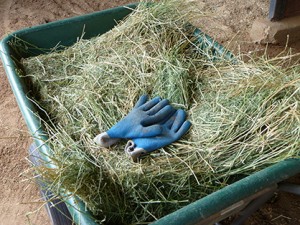Hay Before Grain, or Vice Versa?
By: Dr. Juliet Getty, Ph.D.
Which should be fed first – hay or grain? If you’re feeding correctly, this issue is truly a moot point because the horse should have access to forage (hay and/or pasture) 24/7 with no gaps. Therefore, when fed concentrates, the horse’s digestive tract should already have hay flowing through it.
If fed starchy cereal grains (oats, corn, barley, etc.) on an empty stomach, the horse will produce even more acid (potentially leading to ulcers) and it will leave the stomach quickly. When this happens, there is a risk that it will not be fully digested in the small intestine (especially if large amounts are fed), and end up in the hindgut where starch can be fermented by the bacterial population. This can lead to endotoxin-related laminitis.
If hay is present in the stomach first, it creates a physical barrier for the grain to move out of the stomach as quickly. Starch does not get digested in the stomach, so the grain is simply mixed and churned into a semi-liquid mass, which enters the small intestine where it can be digested down to glucose.
If there is hay present, fiber mixes with the starch and the whole mass enters the small intestine. Fiber is not digested until it reaches the hind gut, but its presence slows down the digestion of starch, and obstructs the absorption of glucose into the bloodstream, leading to a less dramatic rise in insulin.
One thing to note – there is more water involved when hay is present (from increased drinking and saliva production). This is a good thing since digestion within the small intestine cannot take place without water.
Juliet M. Getty, Ph.D. is an internationally respected, independent equine nutritionist who believes that optimizing horse health comes from understanding how the horse’s physiology and instincts determine the correct feeding and nutrition practices. She is available for private consultations and speaking engagements.
Dr. Getty will be speaking June 29 on “The Horse’s Decidedly Different Digestion – The Foundation to Good Health” in Santa Ynez, California. In her presentation, Dr. Getty will take a close look at what makes a horse’s digestion unique and how correct (and incorrect) feeding practices impact longevity, vibrancy, and prevention of obesity, colic, ulcers, and laminitis. The event is hosted by the Renew A Horse Foundation. Reserve tickets by contacting the foundation at info@renewahorsefoundation.com or 805-689-6188. More information is on the web at www.renewahorsefoundation.com.
Dr. Getty’s comprehensive resource book Feed Your Horse Like a Horse is available at Dr. Getty’s website, www.gettyequinenutrition.com, Amazon (www.Amazon.com), Barnes and Noble (www.barnesandnoble.com) and Books A Million ( www.booksamillion.com). The seven separate volumes in Dr. Getty’s topic-centered “Spotlight on Equine Nutrition” series are available at her website, where Dr. Getty offers special package pricing, and also at Amazon in print and Kindle versions.
Dr. Getty’s website, www.gettyequinenutrition.com, offers a generous stock of useful information for the horseperson. Sign up for her free monthly newsletter, Forage for Thought; browse her library of reference articles; search her nutrition forum; and purchase recordings of her educational teleseminars. Plus, for the growing community of horse owners and managers who allow their horses free choice forage feeding, Dr. Getty has set up a special forum as a place for support, celebrations, congratulations, and idea sharing. Share your experiences at jmgetty.blogspot.com. Reach Dr. Getty directly at gettyequinenutrition@gmail.com.











